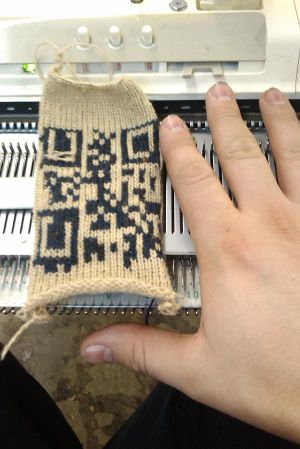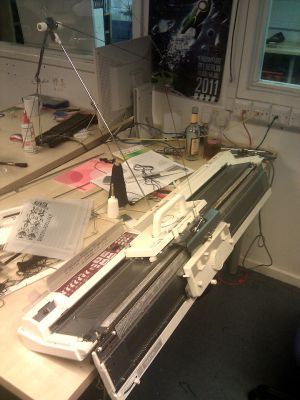Difference between revisions of "Equipment/Knitting Machine"
(→Links) |
m |
||
| Line 43: | Line 43: | ||
*[https://github.com/stg/knittington Knittington], a GUI for the serial interface hack | *[https://github.com/stg/knittington Knittington], a GUI for the serial interface hack | ||
*[http://www.k2g2.org/wiki:blf Brother Liberation Front] more crafting machine hacks | *[http://www.k2g2.org/wiki:blf Brother Liberation Front] more crafting machine hacks | ||
| + | |||
| + | [[Category:Equipment/Textiles]] | ||
Revision as of 18:55, 20 May 2013
We have a Brother KH-950 knitting machine with a pile of attachments which we bought through a pledge in July 2011. This is a computerised knitting machine with the capability of "printing" in two colours from user-supplied patterns (currently through punch-cards and paper, although ideally from USB).
The Bits
Our knitting kit consists of:
- Brother KH-950 Knitting Machine
- Brother KR-850 Ribber
- Brother (?) Colour Changer
- Brother KL-116 Knit-Leader
How to use it
The knitter is a surprisingly complex device - talk to someone who knows how to use it before using it (try Solexious, Russ, or Tom Wyatt). Being shown how to set it up and use it will save you at least an hour and will reduce the chance that you'll break it.
Dispense with your hubris, and read the manual. You might think you're able to use any device without a manual, but this will prove you wrong and leave you looking like a fool. The manual is mostly good (if rather terse and formatted in a fetching, patronisingly sexist shade of pink), but you have to follow it well and take it slowly. And sometimes it glosses over the important bits.
Where it Lives
Please keep the knitting equipment in the correct boxes, or everyone will get confused. The parts live in 5 different boxes:
- The KH-950 knitting machine, in its proper white case with a handle. This contains everything you need to use the knitter itself. When you open the box, observe carefully where everything is, because it's a bugger to put back together. (Instructions on how to pack the knitting machine up are in the manual.)
- The ribber, its accessories (plus a couple of large spares for the knitting machine), in a cardboard box. (Some of these accessories might be useful for using the knitter alone but they are not essential for it.)
- A plastic box with the yarn, elastic, and misc additional knitter accessories.
- The "Knit-Leader" and its tube of supplies, loose.
- The Waitrose bag of knitting books, which includes the manuals for all the devices.
Some inspiration
What can this baby do then?
- Annie Larson’s Colorful Knitwear
- How-To: Hack Your Knitting Machine
- The home of mathematical knitting
Links
- Floppy Drive Emulator
- Brother Accessories Explained
- Knittington, a GUI for the serial interface hack
- Brother Liberation Front more crafting machine hacks

